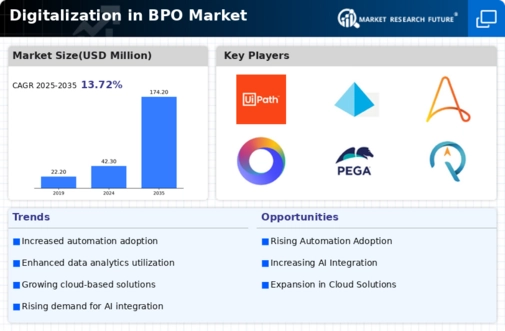Market Trends
Key Emerging Trends in the Digitalization in BPO Market
In recent years, the Business Process Outsourcing (BPO) market has witnessed a significant transformation driven by the digitalization wave. This shift has revolutionized the way businesses operate, manage their processes, and interact with customers. One of the prominent market trends in digitalization within the BPO sector is the adoption of advanced technologies such as Artificial Intelligence (AI), Robotic Process Automation (RPA), and data analytics. These technologies streamline repetitive tasks, enhance efficiency, and enable BPO companies to offer more sophisticated services to their clients.
AI has emerged as a game-changer in the BPO industry, empowering companies to automate routine tasks like data entry, customer support, and document processing. By leveraging AI-powered chatbots and virtual assistants, BPO firms can deliver round-the-clock customer service while reducing operational costs. Moreover, AI algorithms analyze large datasets to extract valuable insights, enabling businesses to make data-driven decisions and improve their processes continuously.
Alongside AI, RPA has gained traction in the BPO market due to its ability to automate manual, rule-based tasks across various business functions. BPO providers deploy software robots to handle repetitive tasks such as invoice processing, order fulfillment, and HR administration with speed and accuracy. This not only boosts operational efficiency but also allows employees to focus on higher-value activities that require human expertise, thus enhancing overall productivity.
Furthermore, data analytics has become integral to digitalization in the BPO sector. By harnessing the power of big data and predictive analytics, BPO companies can uncover valuable insights into customer behavior, market trends, and operational performance. This enables them to offer personalized services, anticipate customer needs, and optimize business processes for better outcomes. Additionally, data analytics helps BPO firms to mitigate risks, identify opportunities for growth, and stay ahead of the competition in a rapidly evolving market landscape.
Another notable market trend is the rise of cloud computing in BPO operations. Cloud-based solutions offer scalability, flexibility, and cost-effectiveness, making them an ideal choice for BPO providers looking to modernize their infrastructure and delivery models. Cloud platforms enable seamless collaboration, data sharing, and remote access to resources, facilitating the integration of distributed teams and improving service delivery across geographies. Moreover, cloud technology empowers BPO companies to adapt quickly to changing client requirements and scale their operations to meet growing demand.
In addition to technology-driven trends, there is a growing emphasis on customer experience (CX) in the digitalization of BPO services. With consumers becoming more discerning and demanding, BPO providers are prioritizing CX enhancements to differentiate themselves in the market. This involves deploying omnichannel communication tools, implementing personalized engagement strategies, and leveraging sentiment analysis to understand and address customer feedback effectively. By focusing on CX, BPO firms can build long-lasting relationships with clients, drive customer loyalty, and sustain competitive advantage in the digital era.
Moreover, the COVID-19 pandemic has accelerated digital transformation in the BPO market, prompting companies to embrace remote work models, digital collaboration tools, and virtual service delivery channels. This shift towards remote operations has reshaped the way BPO services are delivered, with an increased reliance on cloud-based solutions, cybersecurity measures, and virtual workforce management systems. As businesses adapt to the new normal, digitalization will continue to be a driving force in shaping the future of the BPO industry, enabling companies to innovate, optimize processes, and deliver value-added services in a dynamic business environment."

















Leave a Comment